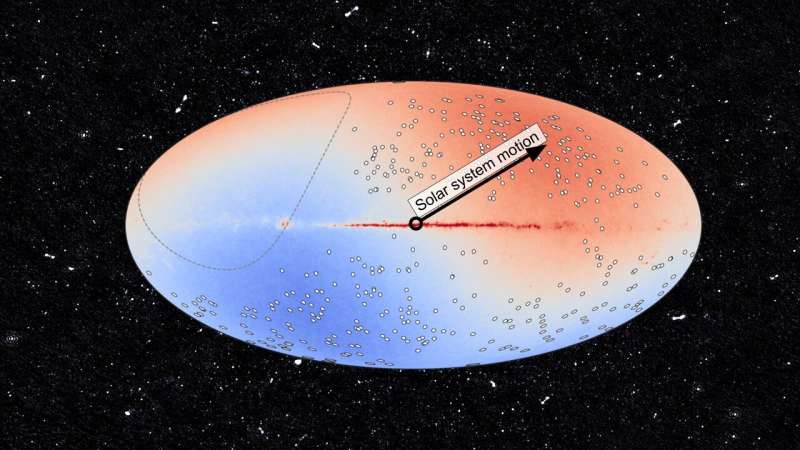
A map of the sky superimposed on a number of MeerKAT points containing several thousand radio sources. On the map, the circles indicate the positions of 391 points, which include a total of 97,1980 sources. The arrow shows the direction of the cosmic dipole. Credit: MALS team
Using MeerKAT data, an international team including astronomers from the MPIfR (Bonn, Germany) has compiled the largest list of radio sources from any MeerKAT survey to date. With this catalog, they were able to measure the cosmic radio dipole, a cosmic effect that arises from the Earth’s motion in the universe and provides an important test of our cosmological theories on the largest scales.
The new catalog and the accompanying scientific results of this study are described in the article published on the preprint server arXivand have been accepted for publication Astronomy and astrophysics.
The new measurement demonstrates the value of MeerKAT’s sensitive data, showing that such deep data provide invaluable insight into the origins of the cosmic dipole effect.
Looking at the sky at radio wavelengths, instead of stars, we see galaxies that are very far away. Observing the radio sky provides an unobstructed window into the evolution of galaxies, black holes, and gas in the universe, and can also reveal what the universe looks like on the largest scales.
The MeerKAT Absorption Line Survey (MALS), designed with the extraordinary sensitivity and imaging accuracy of the MeerKAT radio observatory in South Africa, has produced highly sensitive images that detect nearly one million radio sources from 391 telescope points.
This is the largest catalog ever produced by the MeerKAT survey, one of the few radio catalogs with a million sources or more. Due to its focus on depth rather than sky coverage, many sources have been identified for the first time.
Astronomer Neeraj Gupta says: “The depth and breadth of this continuum catalog is unique among modern radio continuum surveys. The public release enables the community to address a wide range of issues related to the evolution of galaxies and the universe. pay.” at the Inter-University Center for Astronomy and Astrophysics (IUCAA) and Senior Researcher of the MALS project.
To achieve these deep images from the large amounts of raw data generated by MeerKAT, a complex processing pipeline and data storage facility is maintained at IUCAA in India. The images and catalogs were further analyzed and prepared for public release at the Max Planck Institute for Radio Astronomy (MPIfR) in Germany by Jonah Wagenveld, lead author of the paper presented here.
This large catalog enables the MALS team to measure the cosmic dipole – a subtle effect caused by the movement of the solar system around the universe. This effect causes sources to be seen more in the direction of movement and less in the opposite direction.
The direction and magnitude of the Earth’s motion in the universe had previously been determined by measurements of the cosmic microwave background. However, the magnitude of the cosmic dipole effect, which should be directly related to the speed of that motion, is much larger than predicted by many measurements.
This suggests that the dipole may not just be due to the speed of motion, but a real difference in the density of sources in different directions in the sky, something that shouldn’t happen according to cosmological models.
Surprisingly, the new MALS measurement is in line with the predictions. While it is not yet clear why this is the case, it may be related to the survey’s design, which covers small portions of the sky to a very deep level, rather than the larger but shallower sky coverage of other radio surveys. As a result, there are many faint ‘normal galaxies’ in the deep catalogue, which undoubtedly affect the dipole measurement.
“The dipole measurement is a very important test of cosmology and can tell us whether our fundamental assumptions about the structure of the universe are correct,” explains Jonah Wagenold, an astronomer at MPIfR and lead author of the paper.
However, this puzzle remains unresolved and future larger catalogues, either from MALS using MeerKAT’s low-frequency UHF band, or future observatories should elaborate on these findings and resolve the tension.
“Continuous and automated processing was necessary to have a good control over subtle effects in the data that negatively affect the accuracy of our measurements. This new survey is a stepping stone for future large-scale radio surveys, with the Square Kilometer Array and the Deep Synoptic Array. ” notes Hans-Rainer Klöckner, the MPIfR researcher who conceptualized the use of MALS for dipole measurements.
This is the second of several releases of continuum and radio spectral line data to come from MALS, and this data release was a group effort. MALS catalogs and images are publicly available at https://mals.iucaa.in. The MALS team is an international collaboration of researchers from around the world. The project is led by Neeray Gupta of IUCAA India.
More information:
JD Wagenveld et al., MeerKAT 2 absorption line survey data release: broadband continuum catalogs and cosmic radio dipole measurements, arXiv (2024). DOI: 10.48550/arxiv.2408.16619
Presented by the Max Planck Society
quote: Astronomers compile largest MeerKAT radio source catalog to date (2024, September 3) Retrieved September 3, 2024 from https://phys.org/news/2024-09-astronomers-largest-meerkat-radio-source .html has been retrieved.
This document is subject to copyright. Except for any fair dealing for the purpose of private study or research, no part may be reproduced without written permission. Content is provided for informational purposes only.
#Astronomers #compiling #largest #catalog #MeerKAT #radio #sources #date